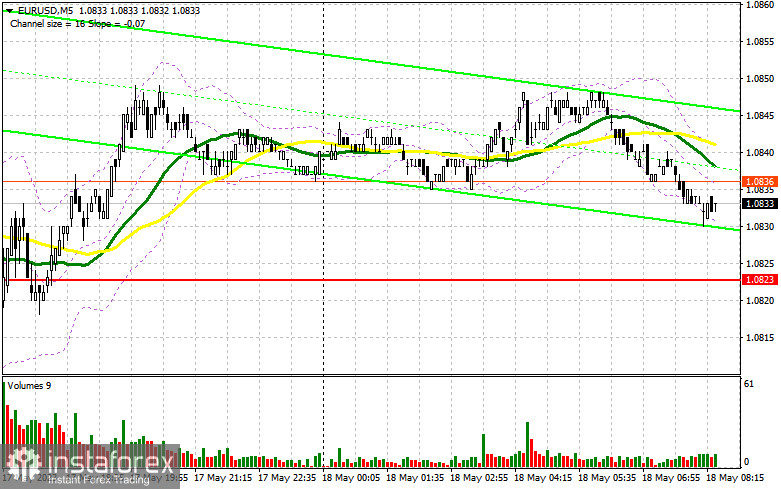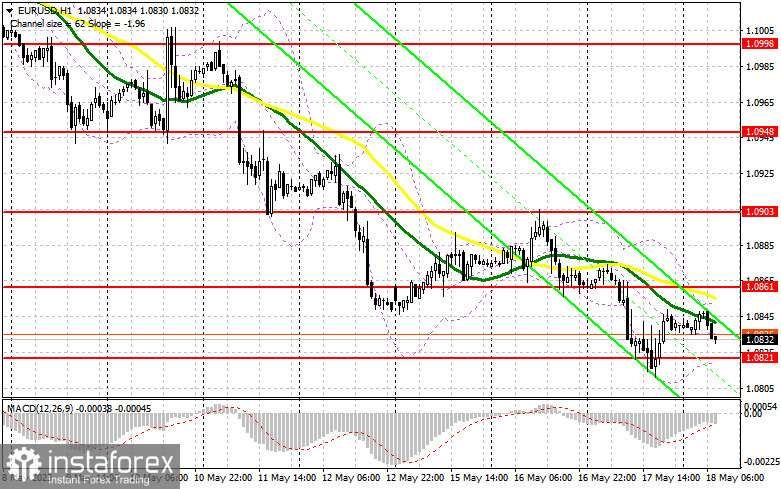Yesterday, several entry signals were made. Let's look at the 5-minute chart to get a picture of what happened. In my morning article, I turned your attention to 1.0833 and recommended making decisions with this level in focus. In the first part of the day, decline and a false breakout through the mark produced a buy signal. But the pair did not rise properly. In the second part of the day, a false breakout of 1.0824 brought about 15 pips.

Conditions for opening long positions on EUR/USD:
The bulls perfectly picked yesterday's lows, taking advantage of the mixed data on the US real estate market. So now they are ready to build a bullish correction. In doing so, the monthly lows might be updated, and we have the speeches of European Central Bank President Christine Lagarde and ECB Vice-President Luis de Guindos to provide us with support. And even though the central bank's strategy has been clear for a long time, their statements might still lead to the euro's surge.
But I'm not in a rush to buy even if the pair is at current lows. In my opinion, it is better to buy on correction from the new support at 1.0821. It will indicate the presence of large traders in the market who are willing to push the euro up at the end of the week. A false breakout there will give entry points into long positions. The pair could grow to the resistance level of 1.0861 where the moving averages are benefiting the bears. Only a breakout and a downward retest of this range after the ECB policy makers' speech will boost demand for the euro and generate an additional entry point for building into long positions. The pair may climb to a high of 1.0903. A more distant target will be the 1.0948 level where I recommend locking in profits.
If EUR/USD declines and bulls show no activity at 1.0821, which is quite likely in such a bear market, a bearish trend will persist. Therefore, only a false breakout of the support level of 1.0790 could give new entry points into long positions. You could buy EUR/USD at a bounce from 1.0748, keeping in mind an upward intraday correction of 30-35 pips.
Conditions for opening short positions on EUR/USD:
The bears are in control, as they constantly push the pair to update weekly lows, maintaining a trend-driven movement. But yesterday's sharp response from the bulls may put it on pause. This is why traders should be very careful when opening new positions at weekly lows. If the bears protect the nearest resistance level of 1.0861, where the moving averages are passing, it will lead to a sell signal. A false breakout of this level could give a sell signal that can push the pair to 1.0821. A decrease below this level as well as an upward retest could cause a fall to 1.0790. A more distant target will be the 1.0748 level where I recommend locking in profits.

If EUR/USD climbs during the European session and bears show no energy at 1.0861, which may occur if ECB representatives show a hawkish stance, bulls will try to return to the market. In this case, I would advise you to postpone short positions until a false breakout of 1.0903. You could sell EUR/USD at a bounce from 1.0948, keeping in mind a downward intraday correction of 30-35 pips.
COT report:
According to the COT report (Commitment of Traders) for May 9, there was a rise in long and short positions. This report takes into account the changes that have taken place in the market after the Fed and ECB meetings. The majority of traders are increasing long positions on the euro. A new downward correction which already occurred last week will provide a buy signal. The euro needs new strong drivers to start a correction. Given that there are no important reports this week and only a few speeches from Fed officials, the pressure on the pair may continue. The COT report indicates that long non-commercial positions jumped by 13,503 to 260,335, while short non-commercial positions advanced by 7,570 to 80,913. At the end of the week, the total non-commercial net position increased to 179,422 against 173,489 a week earlier. The weekly closing price declined to 1.0992 against 1.1031.

Signals of indicators:
Trading is carried out below the 30 and 50 daily moving averages, which indicates a further drop.
Moving Averages
Note: The period and prices of moving averages are considered by the author on the H1 (1-hour) chart and differ from the general definition of the classic daily moving averages on the daily D1 chart.
Bollinger Bands
If EUR/USD declines, the indicator's lower border at 1.0820 will serve as support.
Description of indicators
- Moving average (a moving average determines the current trend by smoothing volatility and noise). The period is 50. It is marked in yellow on the chart.
- Moving average (a moving average determines the current trend by smoothing volatility and noise). The period is 30. It is marked in green on the graph.
- MACD indicator (Moving Average Convergence/Divergence - convergence/divergence of moving averages). A fast EMA period is 12. A slow EMA period is 26. The SMA period is 9.
- Bollinger Bands. The period is 20.
- Non-profit speculative traders are individual traders, hedge funds, and large institutions that use the futures market for speculative purposes and meet certain requirements.
- Long non-commercial positions are the total number of long positions opened by non-commercial traders.
- Short non-commercial positions are the total number of short positions opened by non-commercial traders.
- The total non-commercial net position is a difference in the number of short and long positions opened by non-commercial traders.
 English
English 
 Русский
Русский Bahasa Indonesia
Bahasa Indonesia Bahasa Malay
Bahasa Malay ไทย
ไทย Español
Español Deutsch
Deutsch Български
Български Français
Français Tiếng Việt
Tiếng Việt 中文
中文 বাংলা
বাংলা हिन्दी
हिन्दी Čeština
Čeština Українська
Українська Română
Română

